
Physical Therapy and Its Role in Regaining Mobility
Physical Therapy and Its Role in Regaining Mobility
Author: Geoffrey Advincula, PT

Physical therapy is a discipline of care that uses noninvasive means to help restore function, mobility, and quality of life.
As a physical therapist, I work with patients on treatment strategies that incorporate functional mobility and gait training. My team and I evaluate patients to identify their functional difficulties and limitations, then create an individualized treatment plan focused on optimizing their physical mobility, gross functionality and, ultimately, ambulation.
While you may think it’s only for athletes recovering from injury, physical therapy is used for many areas, including: pain relief; management of chronic illnesses; rehabilitation after stroke, injury or surgery; or prevention of further injury or disability.
If you watch this video below, you'll meet our amazing patient, Norma. In addition to providing surgical intervention and better management of her underlying conditions, the use of physical therapy was instrumental in managing her diabetes and vascular conditions, healing her nonhealing wounds, and, ultimately, regaining the use of her legs.
See how Norma goes from bedridden to walking thanks to the skill and dedication of her multidisciplinary team from Washington Hospital at https://www.youtube.com/watch?v=SPU1owmIfqE&t=53s.
Managing Diabetes and Vascular Conditions
For those with diabetes and vascular conditions, remaining active is important. For Norma, who had limited use of her legs, this obviously presented a challenge. For patients like Norma, physical therapy can be used to strengthen the cardiovascular system, educate patients on proper foot care and management of extremities with limited sensation, and utilizing activity to help control blood sugars.
Healing Nonhealing and Chronic Wounds
Both acute and chronic wounds can impact a patient’s function, to a certain degree. While acute wounds tend to follow a predictable healing pattern, during this process, a person’s mobility and function may be limited. Chronic or nonhealing wounds are most often caused by underlying conditions that impair the healing process. In Norma’s case, function was so limited that she was bedridden and seriously facing the possibility of amputation. To prevent this and promote healing, we collaborated with several specialists, including wound care nurses, and employed various modalities, such as negative pressure wound therapy (NPWT) to help heal her nonhealing wounds and put her on the path to recovery.
Improving or Regaining Mobility
For many, mobility is an integral part of quality of life. In Norma’s case, one of our (and her) main goals was to be able to walk again. Using a personalized physical therapy program and treatment modalities, we helped her with mobility and gait issues by:
- Strengthening muscles
- Building endurance
- Improving balance and coordination
- Improving joint range of motion
- And, ultimately, restoring function to her lower extremities.
While stories like Norma’s may seem extraordinary, it’s the kind of thing that physical therapists get to witness each day. It’s an honor and a privilege to know we helped make it possible.
To learn more about the quality of life-saving work that happens at the Washington Outpatient Rehabilitation Center, visit the Washington Hospital website.
Posted January, 2020
